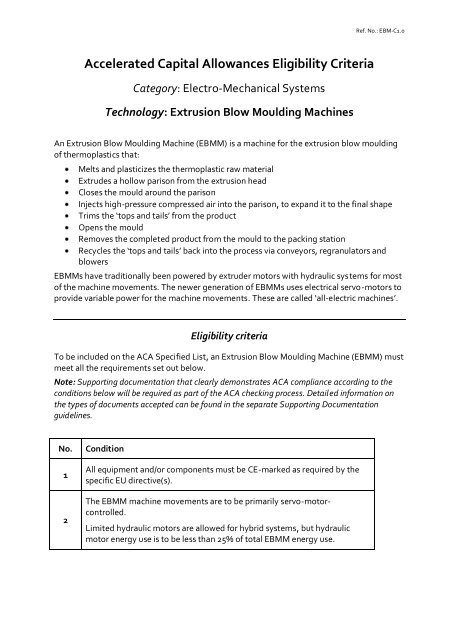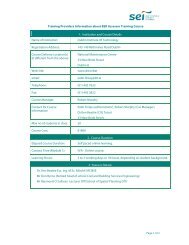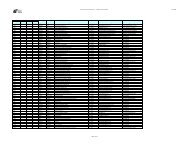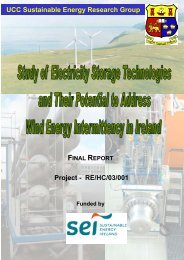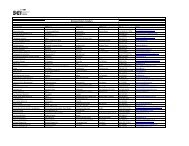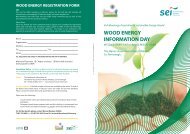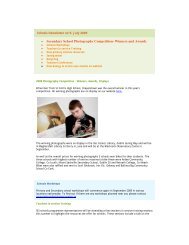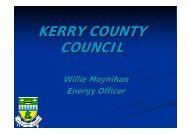Extrusion Blow Moulding Machines
Extrusion Blow Moulding Machines
Extrusion Blow Moulding Machines
Create successful ePaper yourself
Turn your PDF publications into a flip-book with our unique Google optimized e-Paper software.
Ref. No.: EBM-C1.034The average power consumption of the entire EBMM shall be less than:kW = 0.22 x (Production Rate) + 18where the ‘Production Rate’ is measured in kg/hour of total machinethroughput (product + any tops and tails).Appropriate operating and maintenance manuals must be available to theend-user in order to maximise the achievement of potential energyefficiency gains.Notes:1. Some manufacturers will use a ‘hybrid’ technology combining both electric andhydraulic operation for specific machine movements. This allows processors to benefitfrom the advantages of both electric and hydraulic operations. In these cases, thehydraulic element of the power consumption (kW) shall be less than 25% of the totalpower consumption of the EBMM.2. In some existing tooling, hydraulic control of mould movements may be needed, and iscurrently powered from the EBMM’s hydraulic system. In these cases, a hydraulicpower pack may be required to allow existing tooling to be used on all-electricmachines. The power consumption use of any such hydraulic power pack is not includedin the power consumption assessment of the machine.---------------------------------- End of ACA eligibility criteria --------------------------------Please see next section for guidance on:Technical details required in product submissionSupporting documentation required
Ref. No.: EBM-C1.0Guidance on product details and supportingdocumentationNOTE: The following information is not part of the official criteria document publishedwithin the relevant Statutory Instrument. It has been added here for guidance purposesonly in order to help you to provide (a) product details and (b) the required supportingdocumentation.All information contained in this guidance document is subject to change without notice.Technical details required in product submissionThe following are the specific technical values required as part of the product submission forthis technology:Machine TypeAs part of the product submission you must select which type your product is. Eligibleproducts are all-electric or Hybrid units. Only one type can be chosen per submitted product.Production Rate (kg/hr)The ‘Production Rate’ measured in kg/hour of total machine throughput (product + any topsand tails) is required as a value for the product submission. It must be entered as a numberonly without unit symbols. There should also be no spaces or full stops after the numbersubmitted.Average Power Consumption (kW)The Average Power Consumption rate measured in kW is required as a value for the productsubmission. It must be entered as a number only without unit symbols. There should also beno spaces or full stops after the number submitted. The figure must be less than 0.22 x(Production Rate) + 18.Supporting documentation requiredDescribed below is the list of documents that are accepted as proof of compliance for thespecific EBMM.Note: This information will only be requested AFTER you submit your product’s basicdetails onlineImportant Notes to Product ProvidersPlease ensure that you read the “Important Notes to Product Providers” section at theend of this document prior to submitting documentation.
Ref. No.: EBM-C1.0No. Condition Supporting Documentation Requirement1. All equipment and/or components must be CEmarkedas required by the specific EUdirective(s).Official and published manufacturer’s technical data sheet or brochure thatdemonstrates CE marking complianceORA copy of an official signed declaration on headed paper that confirms CE markingcompliance.Official declarations should explicitly state the product for which CE marking is beingconfirmed (i.e. do not provide a letter simply stating general compliance with therelevant ACA condition).Where a document is used to demonstrate conformance for a number of products orrange of products, it should clearly specify each individual product covered by thatdocument.
Ref. No.: EBM-C1.0No. Condition Supporting Documentation Requirement2 The EBMM machine movements are to beprimarily servo-motor-controlled.Limited hydraulic motors are allowed forhybrid systems but hydraulic motor energy useis to be less than 25% of total EBMM energyuse.Official and published manufacturer’s technical data sheet or brochure thatdemonstrates the requirements of the condition.The submitted documentation should confirm that the product is an all-electric orhybrid EBMM that meets the requirement that any hydraulic motor energy usage isless than 25% of the total machine energy usage (including extruder drive).The submitted documentation must confirm the unique machine designation andclearly specify the tonnage of the machine, the drive/s used and the platen size ofthe machine.Note: Changes to drives by the manufacturer to meet customer requirements willrequire a separate ACA submission. This does not include minor changes that do notaffect the basic energy consumption of the EBMM.
Ref. No.: EBM-C1.0No. Condition Supporting Documentation Requirement3 The average power drawn by the EBMM shallbe less than:kW = 0.22 x (Production Rate) + 18where the ‘Production Rate’ is measured inkg/hour of total machine throughput (product+ any tops and tails).Evidence of official testing by manufacturer or independent test lab. As there is nocurrent test standard for determining the machine-related energy for EBMMsmanufacturers may choose a cycle and test process relevant to their specific machinebut must provide complete details of the test method.Test reports should be of the format described in the ‘Important Notes for ProductProviders’ section of this documentNote:The specific machine-related energy consumption of the machine shall bedeclared in kW and be calculated from:Acceptable Power Consumption (kW) = 0.22 x (Production Rate) + 18The production rate (in kg/hour) shall be calculated from the test method usedby the manufacturer.The test results shall include a statement of the production rate (kg/hour) for allmaterial injected by the injection unit.4 Appropriate operating and maintenancemanuals must be available to the end-user inorder to maximise the achievement of anypotential energy-efficiency gains.A copy of an official signed declaration on headed paper which confirms that theappropriate operating and maintenance manuals are provided. Where applicable,information on the availability of technical documentation to download online should begiven.NB: A signed declaration is required to comply with this condition in all cases.Submitting copies of user manuals is not sufficient and not required by this condition.
Ref. No.: EBM-C1.0Important notes for product providersGeneralThere should be a clear link between the product submitted and all supportingdocumentation. This will typically take the form of a product code or product name that can becross-referenced between the submitted product and the relevant supportingdocumentation.If product codes/names have been changed since publication of the supportingdocumentation, then you must provide official evidence of this with the supportingdocumentation supplied.If there is any deviation from these requirements, the supporting documentation will not beconsidered adequate for the purposes of demonstrating compliance with the criteriaconditions. This will in turn delay the submission and/or result in the product not beingconsidered eligible.Where the ACA criteria or help documentation makes reference to compliance withappropriate rather than specific standards, the onus is on the product provider to ensure thatthe supporting documentation supplied references recognised standards that apply to thesubmitted product, i.e. the product must be covered under the scope of a recognisedstandard.If it is subsequently found that any product submitted does not meet the performance orspecification criteria, it will cease to be considered eligible for the ACA.Note: When supplying the supporting documentation through the online process, you mustensure, when demonstrating compliance with the relevant condition, that the correct pagenumber(s) of the document is referenced. When referencing more than one page number,add an explanatory note.Test reportA test report must include an outline of the complete test, including:IntroductionDetails on test conditionsThe specific model details of the product testedThe steps taken in the testThe resultsGraphical representationsConclusionAll documents should be on headed paper and the document should be officially signed off.All documentation must be in English, or include adequate translation.
Ref. No.: EBM-C1.0CertificationWhere certificates are provided, all tests must be carried out by an organisation that isaccredited by a national accreditation body, recognised via the European Cooperation forAccreditation (preferred) or the International Accreditation Forum. All documentation mustbe in English, or include adequate translation.Scientific equivalenceSome ACA criteria conditions allow for scientifically equivalent tests and/or standards to beused.If a product has not been designed, manufactured or tested to the specific standard named,then documentation relating to an equivalent internationally recognised standard may beused, where the phrase ‘or scientific equivalent’ is included in the ACA condition or helpdocumentation.In such applications, the onus is on the product submitter to demonstrate satisfactoryequivalence of the standards. Submissions which reference such supporting documentationmay take longer to process. If the product provider does not provide satisfactory evidence ofequivalence, then the product will not be considered eligible for the ACA. All documentationmust be in English, or include adequate translation.Note: Where specific standards are cited in a condition or in the ACA help documentation,then documentation demonstrating that the relevant products have been designed,manufactured or tested to these specific standards is preferred. Scientific equivalence isconsidered the exception rather than the norm.Representative testingWhere test information is required for a range of technically similar products (e.g.configurations of one base product), then – in exceptional instances – a form ofrepresentative testing may be used once agreed in advance with SEAI.Such testing is where only representative products are tested from a technically similar groupor range of products. Representative testing may form an acceptable basis for supportingdocumentation if:A clear correlation can be demonstrated between the tested product and a technicallysimilar non-tested productandSuch a correlation clearly demonstrates the compliance of the non-tested productNote: Where representative testing is used for a group or range of products, if the tested orrepresentative product is removed from the list of eligible products then all related product sare also removed.


